Your Ultimate Guide to DOOH Advertising
Here’s the truth: ads are everywhere, big banner ads or small banner ads, online, offline, indoor, and outdoor, regardless of the niche. And if you look around, you will see plenty of ads around you, on billboards, on TV, on the side of an article you’re reading, whether online or in a newspaper.
And even if you set up an ad blocker or purchase premium subscriptions for YouTube and Spotify, ads will likely reach you. Or better said, advertisers will.
That’s because businesses can only survive and evolve if they find effective ways to acquire new customers and convert them into advocates.
However, one type of ad, in particular, seems to be holding onto our lives and can follow us from the morning coffees on our devices to the commuting public transport and outdoors while seamlessly blending into our geographical location.
Imagine a new digital creature that is flexible and can adapt in real time to multiple screens and devices. It can travel fast due to its hyper-targeting features and can be effectively measured, as knowing when and where your ad is played unlocks new possibilities.
In short, it is DOOH marketing. But what is DOOH?
Read further, as in the following chapters, you’ll learn everything you need to know about DOOH advertising, from what it is to how it works and, most essentially, how to use it to your business advantage.
Table of Contents
DOOH Advertising Key Takeaways:
- DOOH combines the best of both worlds: Blending traditional billboard reach with digital targeting and updates, creating more engaging ads.
- DOOH offers key benefits: Targeting specific audiences, data-driven optimization, and potentially lower cost than some online ads.
- DOOH metrics: While exciting, there needs to be standardized measurement and some limitations on engagement tracking.
The Dawn of DOOH Advertising: OOH
Out-of-home marketing is the oldest form of advertising. From ancient times to this day, salesmen sell their products and services through written displays for passersby.
Moreover, ads became intense in the 15th century when Johannes Gutenberg created movable type printing, making the process more efficient. Things are pretty straightforward, as there is no ad blocker or premium, ad-free subscription. People will at least notice, if not engage, with OOH ads.
This Out-Of-Home advertising includes anything from billboards, posters, taxis, kiosks, or street furniture, and usually, almost any ad you see outside of your house may be a type of OOH advertising.
Since this method was pretty hard to manage, from printing to installation, and needed to be more sustainable and efficient, DOOH advertising came as a natural response due to its dynamic technological capabilities.
Let’s find out more!
What Is Digital Out-of-Home Advertising?
Let’s start with the definition of DOOH advertising:
DOOH advertising, also known as Digital-Out-Of-Home advertising, is one of the fastest ways of promoting products and services through AdTech-powered solutions, such as screens and other digital creative formats tracked and retargeted to reach its audiences wherever they are outdoors.
Moreover, Digital-Out-Of-Home (DOOH) advertising acts like OOH, but it offers several advantages of the technology used for online advertising. For instance, DOOH gives marketers a more cost-effective advertising method to target specific users to check traffic data, in addition to being interactive and adapting to users’ behavior.

Looking at the DOOH market size and revenue worldwide, we can see that Digital-Out-Of-Home advertising has gained surprising popularity in the past few years. Moreover, DOOH revenue in 2024 is projected to grow by around 17% to over $15.5 billion, while the value until 2028 could reach $21 billion.
It is no wonder advertisers can play with so many features to create stunning and engaging campaigns. The visuals can change according to how users react or even a specific event, such as weather conditions.
Imagine waiting for a bus on a hot day and seeing a digital screen displaying an ad for a cold, icy drink—how cool is that?
The market hits us back with relevant stats from Statista, advising that in 2023, more than 4 out of 10 marketers purchased DOOH campaigns directly, and 3 out of 10 used programmatic buys. Additionally, the programmatic digital Out-Of-Home (prDOOH) campaigns accounted for 57% in 2023.
So, there’s hope for the future of digital advertising, and DOOH advertising stands in the center, bridging the gap between users’ needs and brands’ business goals.
Top 3 Formats of DOOH
Among all forms of Digital out-of-home advertising, three main formats have proven highly effective for worldwide users. Let’s examine them and gain critical insights.
1. Large Format DOOH Ads
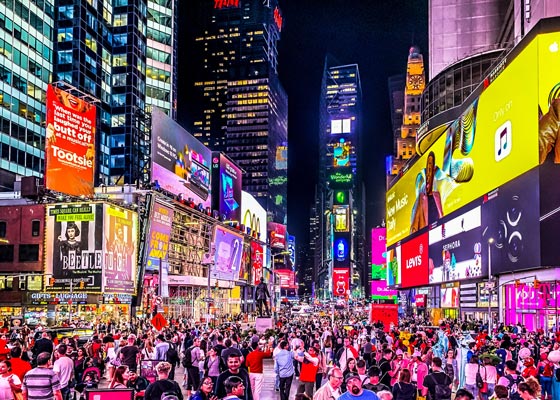
Large-format DOOH ads may be one of the most popular advertising types, as they include billboards, such as those displayed in big, open spaces (e.g., Times Square), urban panels, such as bus shelters, and others.
The main benefit of large-format ads is that they are high-impact, offer a broader target audience exposure, and can be cost-effective.
Large-format media is an excellent choice for brands that want to increase brand awareness or create a buzz around a specific product and aim to reach customers while they are moving.
2. Place-Based DOOH Advertising
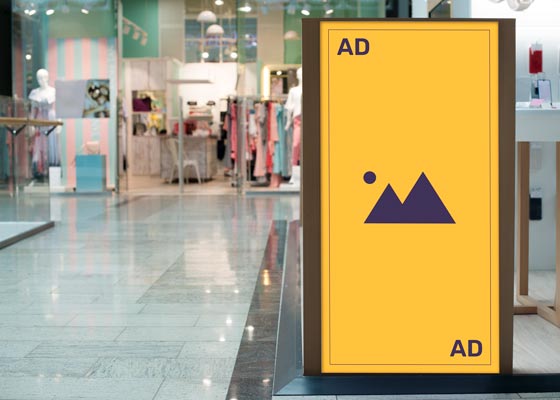
Place-based media, known as location-based ads, allows businesses to engage with customers in public spaces like malls, gyms, gas stations, and cabs. Thus, brands must ensure consistency between the users’ location, the ad message, and the CTA. For instance, a screen placed in a gym should show ads about sportswear, food supplements, or other contextual products and services instead of a donut shop, which could be weird, right?
Furthermore, when it comes to grocery shopping, place-based ads can be placed near cashiers, thus influencing some last-minute buying decisions.
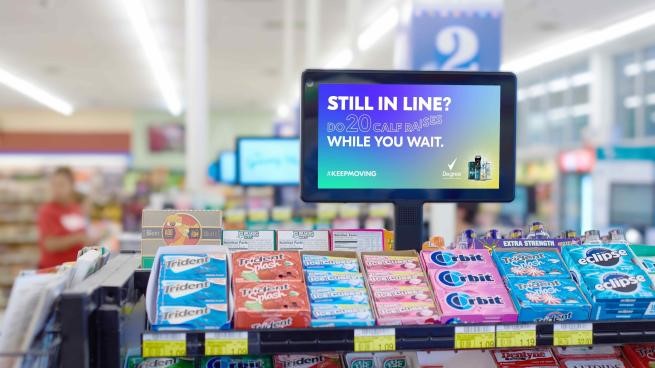
Therefore, the main benefit of this DOOH ad format is high customization while reaching contextual relevance and captivating users’ attention while performing their daily activities.
3. Point-of-Purchase
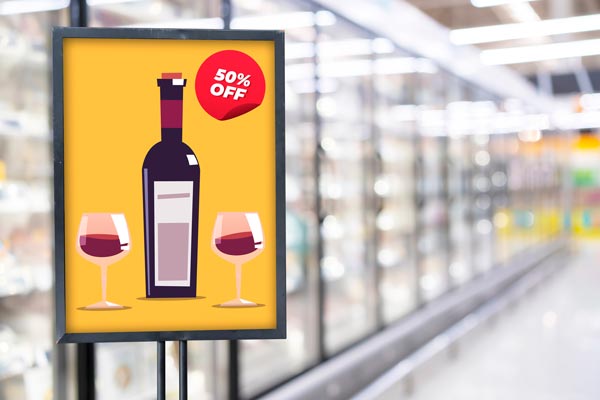
Another type of DOOH advertising that works great for some brands is Point-of-Purchase (POP) advertising, which can be seen in supermarkets and stores in some specific locations, such as right at the store’s entrance, thus influencing users buying decisions.
However, while Place-Based ads can be found close to cashiers, Point-of-Purchase screens will be placed inside a store along the aisles. For instance, if somebody wants to place an advertisement about a wine brand, the screen will be in the “alcoholic drinks” aisle.
This type of DOOH advertising helps marketers influence consumers’ purchasing decisions while in the store, thus becoming increasingly relevant.
If you have bread X in your cart and you see a POP ad about bread Y, that ad should prompt you to switch brands and choose the advertised one.
Top 5 Benefits of Using DOOH
It is not surprising that DOOH advertising has many great benefits. The fact that old Out-Of-Home practices have been enhanced with digital features could come with only a few downsides, as the digital era has improved many processes across many industries.
1. Customized Targeting
Digital-out-of-home advertising allows marketers to target users more precisely and can be programmed to engage consumers with the right message at the right time. The main reason is that screens can display various messages or visuals depending on movement patterns or consumer behavior, thus offering a more relevant experience.
Furthermore, targeting can be based on geofence, weather conditions, audience concentration, or proximity to a point of interest.
Customizing targeting may be one of the most significant advantages of Digital-Out-Of-Home advertising. This way, marketers can deliver an ad to consumers most likely interested in a brand’s products.
2. Programmatic Advertising
DOOH works with programmatic ads, so advertisers can easily access data about their campaigns, while visuals and CTAs can change based on data-driven decisions. For instance, a DOOH ad can adapt to the audience by consulting real-time metrics, which can improve the overall performance of a DOOH campaign.
3. Personalized Advertising
Indeed, Out-of-Home advertising helps businesses engage customers based on a static ad, while DOOH has a remarkable advantage in acquiring new customers in a specific and targeted manner. Digital-out-of-home ads benefit from personalized advertising, as they can become more relevant to consumers by using insights and data about their behavior and interests.
4. Higher Engagement Opportunities
As 62% of consumers notice digital billboards, DOOH allows advertisers to adapt their campaigns to increase engagement based on specific metrics, such as location, weather, contextual advertising targeting, etc.
This is a significant advantage of Digital-Out-Of-Home advertising, as its digital features provide multiple engagement opportunities. Therefore, ads can change based on recent events, thus acquiring new customers with more relevant elements.
5. First-Party Data
DOOH advertising allows marketers to use first-party data to improve their campaigns and attract new customers. For instance, first-party data can help brands place their ads in more popular locations with consumers interested in their products.
How to Measure Your DOOH Campaigns
We have already discussed how beneficial DOOH advertising is. By setting up customized ads, businesses can raise awareness and increase the customers they attract. However, building a DOOH campaign should not be the last step of your strategy, as you must know if your ads worked, what worked, and how to improve your game.
Also, it is essential to examine the entire marketing funnel to determine the effectiveness of your DOOH campaigns, not from a single focal point but from a broader perspective.
However, we’ll break it down in the following chapters.
Different Metrics to Step Up Your DOOH Ad Campaigns
First, you could objectively assess your brand health, including general brand efforts, loyalty programs, product launches, competitive awareness, and user intent.
Then, implement a foot traffic study to determine the number of visits to your nearby DOOH location. This way, marketers can base some of their results on sensor technology and get estimated foot traffic impressions in real-time.
Furthermore, a brand can use location intelligence technology to track the mobile IDs exposed to the specific media that complete an action regarding the brand, whether online or offline.
Advertisers can also measure their campaign’s results through digital marketing analytics and specific web metrics in Google Analytics.
Additionally, they can add a QR code to their ad and check the insights regarding page visits for that specific link, measuring the user actions and bounce rate, or create an SMS offer, thus encouraging consumers to text them and get a reply containing a link or a promotional code.
There are endless possibilities, so you must find the right measuring tool and strategy to meet new users or retain old ones where they get lost.
DOOH Advertising Difficulties and Limitations
Even if DOOH advertising comes with significant advantages, this relatively recent advertising method has some downsides, too.
For example, one of the advertisers’ most significant challenges is comparing results from various providers since Digital-out-of-home advertising has yet to have standard metrics.
Therefore, DOOH advertising is more challenging to measure than online campaigns, making it difficult and indicative to compare prices for DOOH and digital impressions.
However, not all users engage with it, and even if technology has evolved remarkably, it still cannot provide an exact number of DOOH impressions.
Integrating DOOH into Your Marketing Campaigns
Digital-out-of-home advertising helps businesses raise awareness about their products and services through highly visible methods, such as billboards, bus shelters, or screens in grocery stores, which are seen by many consumers.
The fact that ads can change based on user behavior and real-time events can help brands become more relevant to potential customers.
Furthermore, DOOH has seen increased popularity in the post-pandemic market, as 71% of consumers have been more interested in walking around their town or neighborhood. Thus, DOOH is as visible as possible.
Regarding pricing, DOOH spends less on ads than online advertising. For instance, Alfi, an AI company, runs on a CPM (Cost per Mile) model, and its advertising rate is between $1.50 and $5.21. In comparison, Facebook’s average CPM is over $14.
Other pricing models for DOOH advertising exist, including campaign-based pricing, in which advertisers set a specific goal, such as a certain number of impressions.
DOOH GCPs
DOOH is still a new advertising method, but brands quickly used its digital features to create interactive campaigns for their potential customers.
Digital 3D Billboards

Source: AVNetwork
Digital 3D billboards are extraordinarily detailed and catch everyone’s attention with their visuals. They can acquire new customers through videos that seem to get out of the screen and amaze each person who passes the ad.
Take Nike’s example. The company created a 3D billboard campaign that ran in Tokyo, Japan. The video displayed various Nike sneakers, and while the campaign had pure selling purposes, it also entertained everyone passing by the billboard.
While simple OOH billboards might remain unnoticed, the chances of missing a gigantic billboard displaying 3D videos of Nike sneakers will surely be noticed by every passerby.
Weather-Based Ads

Weather-based ads are a great example of campaigns that adapt to real-time changes.
Like the example we discussed earlier, an ad displaying a cold drink on a sunny day or a hot one on a cold, rainy day can increase sales based on the current weather.
For example, take McDonald’s’ campaign, which aims to promote cold drinks at the McCafé through a weather-reactive DOOH campaign.
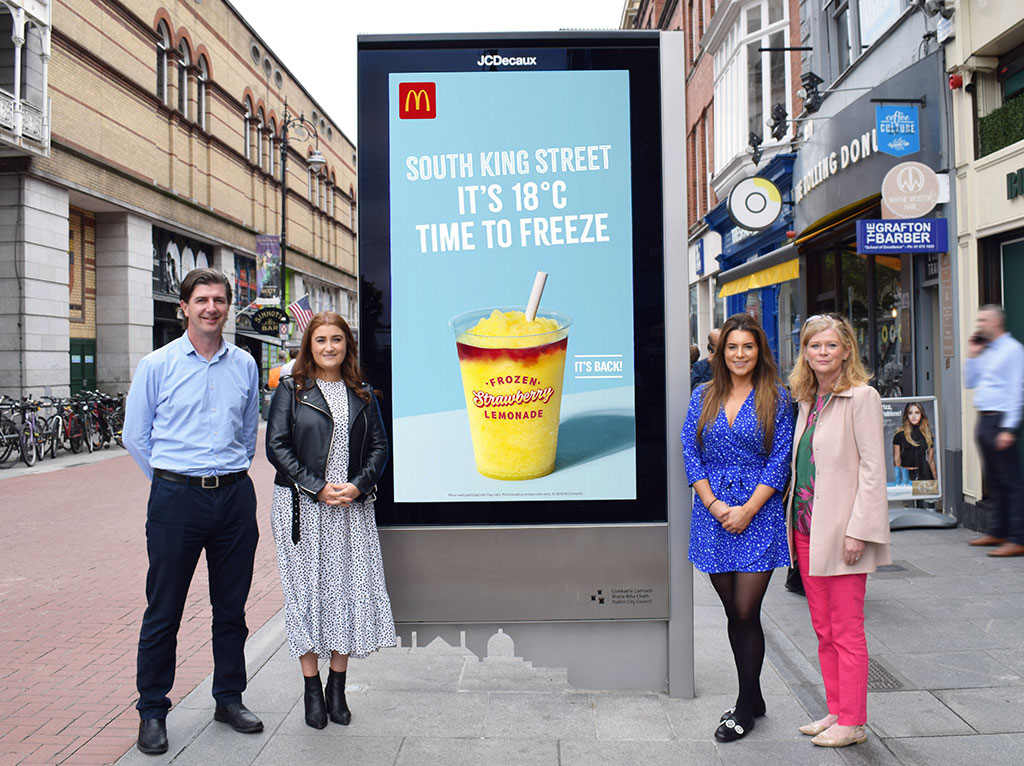
Event-Based Ads
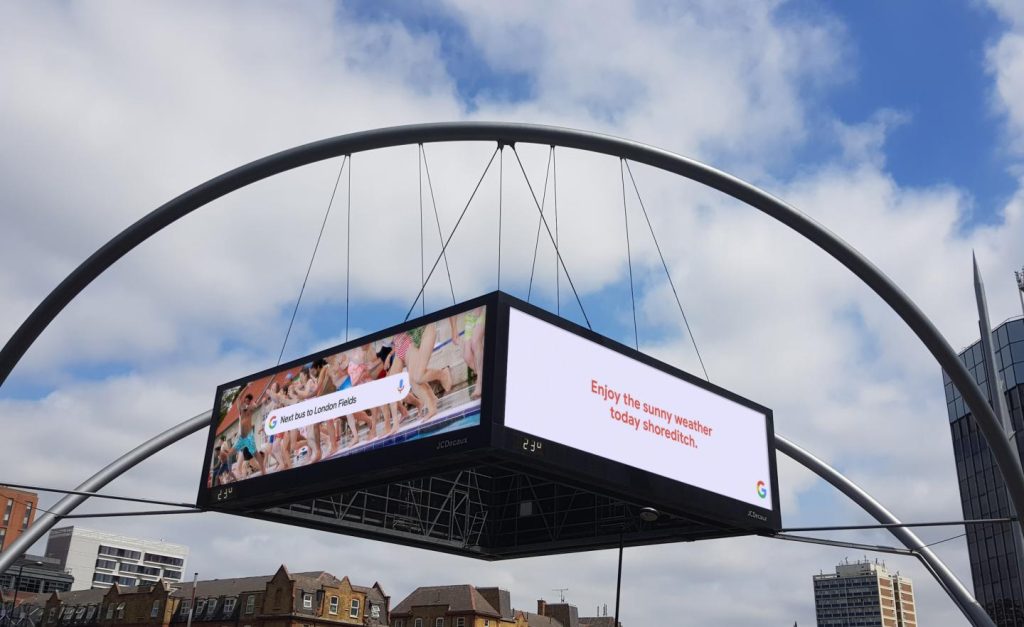
Google Maps has built an excellent campaign using real-time data, such as temperature, weather, time of the day, or cultural events. They recommended many places, products, and events by creating hundreds of variants in over 400 locations that helped them engage with their audience from the United Kingdom.
A great campaign developed by the tech giant was “Google Explore,” which focused on encouraging individuals to discover various cities, restaurants, coffee shops, and many more. The ads were weather, time, day, and location-specific.
This is the power of event-based ads. They focus on being as relevant as possible, and this is a crucial practice when working with DOOH advertising.
If you do not concentrate on relevancy, your ads might not reach the results you and your team were expecting.
Interactive Ads
Interactive ads are beneficial when aiming to engage consumers, as people are easily attracted to customized campaigns.
For instance, GMC created a DOOH campaign by using responsive facial recognition. The screens displayed a man next to a GMC SUV that interacted with consumers based on their reactions.
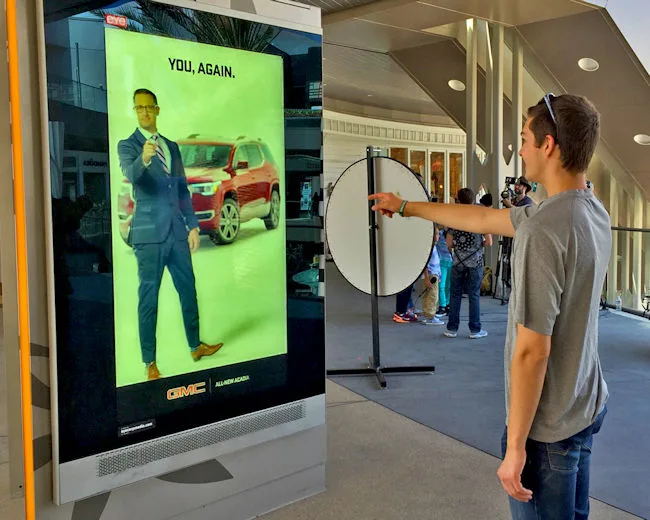
Nescafe is another excellent example of interactive ads. They created a game in a Shanghai metro station to promote their new Cold Brew products, where users could move in front of the screen to catch drops in a Nescafe bottle and then be able to get a Cold Brew bottle if they filled the bottle in 30 seconds.

The Future of DOOH
Just as technology is evolving faster than we have ever imagined, DOOH is doing the same, using many digital features to display campaigns that will engage as many consumers as possible.
DOOH will become increasingly popular soon, and with the help of AI (Artificial Intelligence), ML (Machine Learning), and other technologies, marketers will find it even easier to build DOOH campaigns.
DOOH also aims to provide greater integration with other media and channels, new ways of tracking results, and more accurate insights into various campaigns.
In Conclusion
DOOH (Digital-Out-Of-Home) advertising uses the practices already developed in OOH (Out-Of-Home) to provide an advertising method that helps marketers create engaging campaigns through many digital features.
Some of the most significant benefits of DOOH are customized targeting, the ability to use programmatic and personalized advertising, and higher engagement opportunities.
DOOH has proved to be a more cost-effective advertising method, with its advertising rate lower than Facebook’s.
There are many improvements that need to be made regarding DOOH. Still, with the help of well-developed technologies such as AI and ML, Digital out-of-home advertising will become a significant part of big and small brands’ marketing strategies.